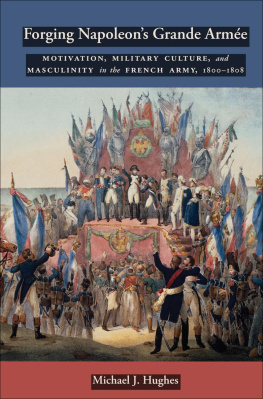Stanford University Press
Stanford, California
2016 by the Board of Trustees of the Leland Stanford Junior University. All rights reserved.
No part of this book may be reproduced or transmitted in any form or by any means, electronic or mechanical, including photocopying and recording, or in any information storage or retrieval system without the prior written permission of Stanford University Press.
Printed in the United States of America on acid-free, archival-quality paper
Library of Congress Cataloging-in-Publication Data
Jensen, Benjamin M., author.
Forging the sword : doctrinal change in the U.S. Army / Benjamin M. Jensen.
pages cm
Includes bibliographical references and index.
ISBN 978-0-8047-9560-9 (cloth : alk. paper) ISBN 978-0-8047-9737-5 (pbk. : alk. paper)
1. United States. ArmyReorganizationHistory20th century. 2. United States. ArmyReorganizationHistory21st century. 3. Military doctrineUnited StatesHistory20th century. 4. Military doctrineUnited StatesHistory21st century. 5. Organizational changeUnited StatesHistory20th century. 6. Organizational changeUnited StatesHistory21st century. 7. United StatesMilitary policy. I. Title.
UA25.J525 2016
355.033573dc23
2015017618
ISBN 978-0-8047-9738-2 (electronic)
Typeset by Newgen in 10/14 Minion
Foreword
One of our most important duties as Army professionals is to think clearly about the problem of future armed conflict. That is because our vision of the future must drive change to ensure that Army forces are prepared to prevent conflict, shape the security environment, and win wars.
General David G. Perkins, The U.S. Army Operating Concept: Win in a Complex World
WAR IS THE FINAL AUDITOR OF MILITARY ORGANIZATIONS. One of the greatest challenges confronting the military professional is how to build a learning organization that implements lessons and anticipates the challenges of future armed conflict. Anticipating the future begins with an analysis of the present and an understanding of history. Consideration of continuities in the nature of war as well as changes in the character of warfare is essential to making wise decisions about future force development. Grounded projections into the future serve as the basis for military innovation and how leaders prepare their soldiers and units for the challenges of future war. As the historian Sir Michael Howard observed, No matter how clearly one thinks, it is impossible to anticipate precisely the character of future conflict. The key is to not be so far off the mark that it becomes impossible to adjust once that character is revealed. In this book, Benjamin Jensen offers important insights into how militaries learn, adapt, and sustain innovation to ensure that, when called on to fight, they do not find themselves too far off the mark.
Of particular importance is Jensens emphasis on the need for creative forums in which leaders and soldiers experiment and visualize new forms of warfare. Military leaders need a space to imagine future war and develop new theories of victory to test through experimentation. Innovation begins with leaders cultivating creative space. Jensens observation that experimentation is necessary to test concepts and challenge assumptions about future war is consistent with the finding of historians MacGregor Knox and Williamson Murray in The Dynamics of Military Revolution, 13002050 that
the key technique of innovation was open-ended experiment and exercises that tested systems to breakdown rather than aiming at the validation of hopes or theories. Simple honesty and the free flow of ideas between superiors and subordinateskey components of all successful military cultureswere centrally important to the ability to learn from experience. And the overriding purpose of experiments and exercises was to improve the effectiveness of units and of the service as a whole, rather than singling out commanders who had allegedly failed.
Successful military experimentation evaluates ideas, challenges assumptions, and tests new concepts.
The U.S. Army defines innovation as the result of critical and creative thinking and the conversion of new ideas into valued outcomes. Ben Jensens insights are consistent with the Armys effort to develop and mature concepts, assess those concepts in experimentation and other learning venues, and use what is learned to drive future force development. Critical and creative thinking about future armed conflict requires consideration of threats, enemies, and adversaries; anticipated missions; emerging technologies; and historical observations and lessons learned. Ultimately, innovation requires the development of new tools or methods that permit military forces to anticipate future demands, stay ahead of determined enemies, and accomplish the mission. Invention is not innovation. Innovation often results from the identification of opportunities to use existing capabilities in new ways. And while technology helps shape the character of warfare, military forces gain differential advantage over enemies through the integration of technologies with adaptive leaders and well-trained organizations based on a sound concept of how to fight. As the late historian I. B. Holley Jr. observed, Unless the armed forces are guided by appropriate doctrines, greater numbers and superior weapons are no guarantee of victory.
The role of doctrine in military innovation is often overlooked. Doctrine, though not prescriptive, is what a military institution teaches in professional education and in the training of operational forces about how those forces accomplish military objectives. Jensen points out the importance of incubators (informal subunits outside bureaucratic structures) to develop sound doctrine as well as advocacy networks to implement that doctrine through changes in organization, training, materiel development, leader education, and personnel policies. Forging the Sword: Doctrinal Change in the U.S. Army contains important insights into how to foster learning organizations that can anticipate the challenges of future armed conflict and develop the ability to meet those challenges.
Lieutenant General H. R. McMaster
Director, Army Capabilities Integration Center
Deputy Commanding General, Futures, U.S. Army Training and Doctrine Command
Acknowledgments
AS THIS BOOK SHOWS, NO ONE PERSON OWNS AN IDEA. Networks of individuals exchange theories and observations, as stories, whose circulation creates a combustible environment conducive to novel insights. While there are many hubs in my network, I thank two people who proved especially helpful to this project in its early stages: Charles Tilly and Christopher Layne. These senior scholars helped a young U.S. Army officer see the world through a different lens. I also thank Dean Jim Goldgeier and the International Affairs Research Institute in the American University School of International Service for creating an academic environment encouraging scholars to bridge the gap and address important policy issues. It funded a book incubator that helped shape the final form of the manuscript. I am similarly grateful to the Smith Richardson Foundation for supporting the research that led to this book. In addition, the book benefited from the generous support provided by Donald L. Bren, the Marine Corps University Foundation, and Marine Corps University. I am also forever indebted to mentors Abdul Aziz Said and John Richardson, as well as my family, for teaching me empathy and patience. Last, this book would not have been possible without the assistance of Stanford University Press, and especially Geoffrey Burns and James Holt.













